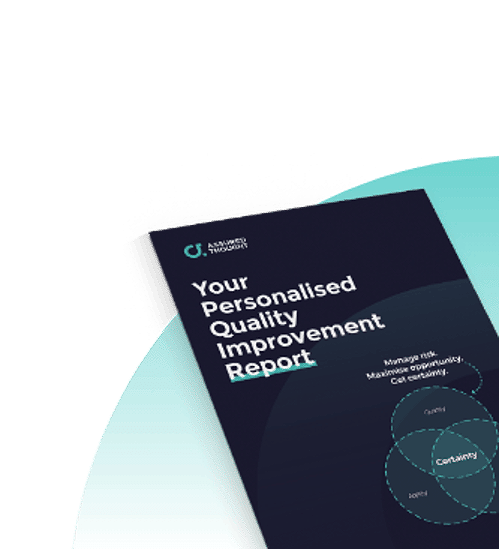Resource
Quality engineering vs quality assurance | 2025 Guide
24 Jun 2025
Software powers everything today – from local councils to fintech startups. Release cycles now run in minutes rather than months, yet users demand flawless reliability. Traditional ‘find the bug at the end’s testing no longer scales. The conversation has shifted from post-facto quality assurance to proactive quality engineering. In this month’s blog, Dom Tovey, Head of Delivery at Assured Thought, explains why that matters – and how UK test professionals can start the shift today.
Why shift from QA to QE?
Historically, quality assurance (QA) focused on verifying built software against requirements, often through manual tests, sign-off processes and defect metrics.
In contrast, quality engineering (QE) integrates testing, DevOps and observability throughout the software lifecycle. QE aims to design systems that prevent bugs, not just detect them. QA is often a phase; QE is a mindset shared across the team.
QA asks: ‘Does it work?’
QE asks: ‘How do we ensure it can’t break?’
Three drivers of this evolution:
- DevOps and CI/CD: Automated pipelines leave no room for manual bottlenecks.
- Complex architectures: Microservices and APIs need early testing and production telemetry.
- Customer expectations: A single outage can ruin NPS scores; prevention saves money and reputation.
QA vs QE: Key differences
| Axis | Quality Assurance | Quality Engineering |
|---|---|---|
| Focus | Defect detection | Defect prevention and resilience |
| Timing | Mostly post-development | Embedded from planning to production |
| Skills | Manual testing, scripted checks | Automation, CI/CD, observability |
| Ownership | Testers as gatekeepers | Whole team owns quality |
| Metrics | Defect leakage, pass rates | MTBF, Availability, NPS, Deployment Frequency, Automation Rate, Risk-weighted coverage |
| Artefacts | Test cases, bug reports | Infra-as-code, contract tests, dashboards |
| Career path | Tester → Test Manager | QE → SDET → Architect/SRE |
Tooling along the SDLC
| Function / Need | Typical QA-era Tool | Modern QE-oriented Tool | How the QE Tool Changes the Game |
|---|---|---|---|
| Test case and requirements management | HP ALM / Quality Centre, TestRail | Xray or Zephyr inside Jira, Allure TestOps | Moves test assets into the same git/Jira workflow as code; version-controlled, API-driven, and CI-aware |
| Manual / record-playback UI testing | QTP (UFT), Selenium IDE | Cypress, Playwright, WebdriverIO | Code-first, headless and pipeline-friendly; runs on every commit instead of after a build freeze |
| Bug and defect tracking | Bugzilla, standalone Jira project | Jira integrated with DevOps boards and auto-ticketing from CI failures | Defects are raised automatically from failing tests and linked to commits, closing the feedback loop |
| Performance testing | LoadRunner, standalone JMeter | k6, Gatling, Locust scripted in code and invoked in CI/CD | Perf scripts live in git, run on ephemeral environments and gate merges |
| Security scanning | Ad-hoc Acunetix or Nessus scans | OWASP ZAP automated in pipeline, Snyk / Dependabot for code and OSS | Shift-left security: every pull request triggers a scan; vulnerabilities break the build |
| Static code analysis | Spot checks or none | SonarQube, GitHub CodeQL as mandatory quality gate | Enforces code quality and CWE rules before code reaches test |
Tip: even legacy Selenium scripts become valuable again when containerised and run in an immutable CI pipeline.
Evolving the tester role
Today’s testers are T-shaped:
- Breadth: Infra, accessibility, security, and privacy.
- Depth: Specialisms such as performance or contract testing.
- Full-lifecycle impact: From early design to post-release analysis.
- Mentorships: QEs coach teams, write testable stories, and embed quality habits.
Career paths now stretch toward SRE, platform engineering, or product roles where systemic thinking is essential.
Your 7-step QE kickstart plan:
- Baseline assessment – capture today’s people, process, tooling and outcomes so action starts from fact, not guesswork.
- Prioritised roadmap – translate gaps into a sequenced plan of quick wins and strategic moves tied to business risk.
- Collaboration in design – run cross-functional design reviews and risk-storming early, making quality a shared design responsibility.
- Unified metrics dashboard – surface real-time quality, flow and reliability data to turn debate into data-driven action.
- Shift-left automation and quality-by-design – embed unit/API tests, coding standards and peer reviews to prevent defects at source.
- Continuous upskilling and coaching – spread modern tools and mindsets through pairing, workshops and communities of practice.
- Iterative improvement and re-assessment – hold retros, fix root causes and re-measure every 5-12 months to keep momentum and recalibrate the roadmap.
Quality engineering isn’t just rebranding it’s rethinking the ways software is built. By treating quality as code, data and shared responsibility, teams ship more quickly and safely.
Ready to get started?
Assured Thought offers QE maturity workshops, tooling audits and enablement for UK tech teams. Book a discovery call and start engineering confidence into every release.




